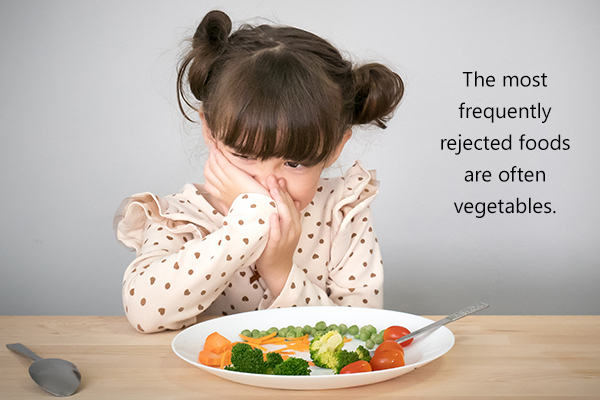In this article:
Many parents have experienced their child or children going through phases of picky eating, especially in early childhood.

While there is currently no formal definition for picky eating, for many families, the experience includes children restricting food choices to only some acceptable foods.
This restriction can sometimes include an element of “neophobia” or fear or unwillingness to try new foods. Other times, a child will go through a phase of loving a certain food and then refusing to eat it at all.
It is difficult to know whether and when a child will outgrow this choosiness with food, which becomes even more frustrating for parents.
What Causes Picky Eating?
It is uncertain what causes picky eating and whether it is due to a child’s personality or a lack of exposure to different foods. In extreme cases, it can be less of choosiness but a complete aversion to food or eating.
While there is no immediate danger to children being picky eaters, some children end up restricting their intake to only a few different foods, limiting their sources of nutrition. (1) Usually, the accepted foods are not the most nutrient-dense.
Problems Associated With Picky Eating

With some picky eaters, there can be problems with adequate weight gain and growth or risk of certain micronutrient deficiencies. The most common of these deficiencies can be calcium (from lack of dairy), iron (from lack of red meat or beans), or omega-3 fatty acids (from an unwillingness to eat fish, nuts, seeds). (2)
Working with a registered dietitian can help families identify which nutrients may be lacking in the diet and how to include them.
Emotional Effects of Picky Eating
Beyond the physical side effects, a noticeable consequence of picky eating is the emotional toll on the family. The dinner table becomes less of a place to enjoy a meal together and instead feels more like a battleground over who should eat what and how much.
The Concept of “Division of Responsibility” in Feeding

The concept of the “division of responsibility” in feeding, which was founded by Ellyn Satter, outlines the principles of parents providing structure in which children choose what to eat.
The division of responsibility suggests that parents should choose the “when,” “where,” and “what” of eating. Children then decide “what,” “whether,” and “how much” to eat. (3)
As an example:
- Parents’ responsibilities in feeding their children could be to decide that the family will eat dinner at 6:00 in the evening at the kitchen table.
- Parents or caretakers would also choose what to have for dinner – for example, pasta with meatballs and roasted vegetables, a side of salad, and sliced fruit for dessert.
- Children are then provided with the responsibility to choose whether to eat any of these foods, which of the options they want, and how much to eat.
- Regardless of their choice to eat all, some, or none of the presented dinner, the child does not get to go searching for something else to eat in the kitchen.
Advantages of this strategy:
- Knowing that parents are only responsible for part of the feeding process frees parents from the stress of their child choosing not to eat.
- Not having adults bribe and/or command over what to eat frees the child from the pressure of eating a certain way.
- Meals no longer have to be a point of contention within families. Instead, children are offered a space in which they can learn to self-regulate hunger and have room to dislike certain foods (as most adults do too).
How to implement it:
To reduce the stress on both caretakers and children, it is best to embrace the division of responsibility in feeding. Not only does it build healthy habits, but it also eases the tension between family members.
Starting young is important, especially in preventing aversions to food and eating, but the guidelines can be adopted at any point.
For most picky but otherwise healthy children, parents can play a role in reducing the choosiness by providing structure and support in which children learn to become comfortable with a variety of foods.
The Most Rejected Food by Children

The most frequently rejected foods are often vegetables. This rejection of vegetables can be due to several possibilities, the most common being:
- Some children and people are “supertasters” to whom even slightly bitter flavors will taste very bitter, often fueling their aversion to vegetables.
- Another potential reason for the rejection of vegetables is that, at a young age, children might learn that vegetables are “gross” or food that they need to be bribed to eat.
Reduce Your Child’s Aversion to Vegetables Without Any Compulsion
Kids may pick up on the fact that, for some reason, their parents always want them to eat vegetables before they are allowed to eat dessert or leave the dinner table.
An unintended consequence is that eating vegetables, or not eating them, becomes a bargaining chip for children. (4) That’s not to say that we have to force them down.
Vegetables can be prepared and eaten in several different ways, and a key part of increasing vegetable intake is figuring out which way tastes best to the entire family, whether that be in salads, in soups, roasted, steamed, or stir-fried.
Introduce Your Child to New and Diverse Foods
1. Be patient
One of the most important things to remember is that feeding children and teaching them to eat a variety of foods take time.
Even if adopting the division of responsibility tonight sounds like a good idea, that does not mean children will immediately start to eat everything they would not eat before.
Children need time to learn the new way and adapt to having a choice over what they eat.
2. Be persistent
A lot of foods will need to be introduced several times (research shows even up to an average of 10 times!) before a child will finally decide to taste the food. (5) Most kids need to see the new food, smell it, and lick it before they chew and swallow the food.
Some parents make the mistake of only preparing the foods they know the child will eat, out of desperation to nourish the child at all.
However, if you do not offer the food, you are eliminating the opportunity for them to ever try it. Even though it will not happen instantly, continuing to offer will consistently give the children a chance to decide.
Final Word
Overall, most picky children are not at risk for immediate health issues. However, families may feel a strain on their family dynamics around eating. Many families would benefit from counseling with a dietitian. Children with extreme aversions or concerns for micronutrient deficiencies should seek individualized medical advice.
For many others, a good place to begin would be to adopt the division of responsibility and create a supportive, structured environment that eases the pressure off of both parents/caretakers and children. With time, consistency, and patience, children might just start to eat vegetables on their own – no bribery required.
- Was this article helpful?
- YES, THANKS!NOT REALLY


